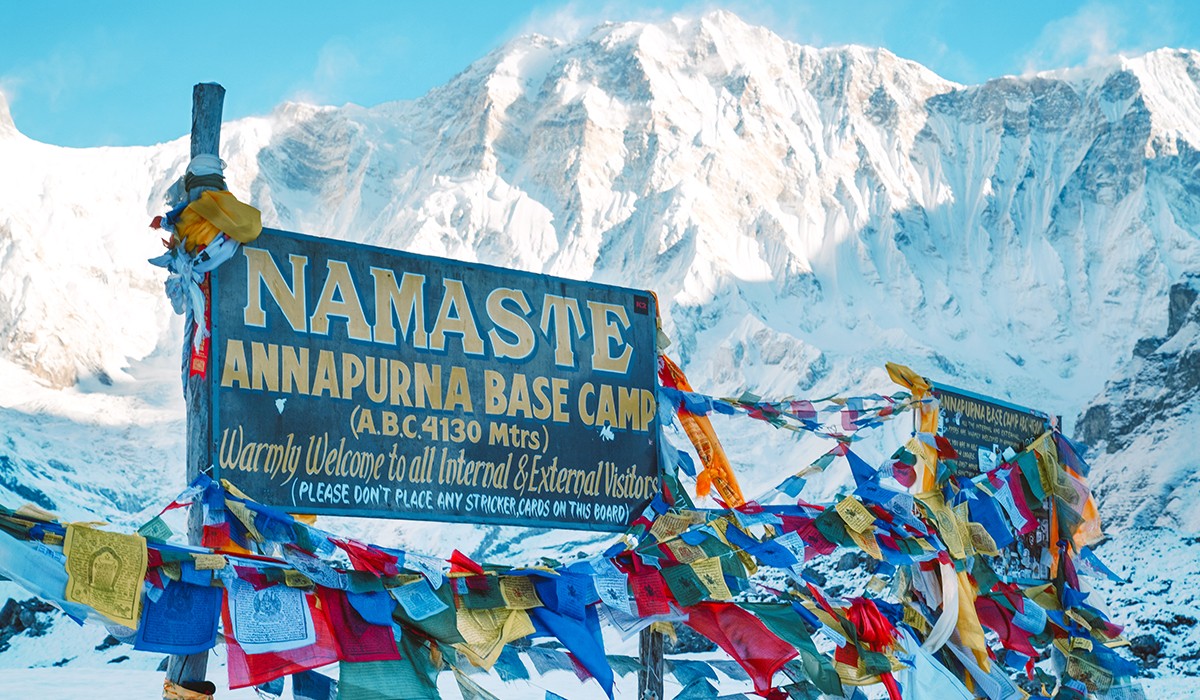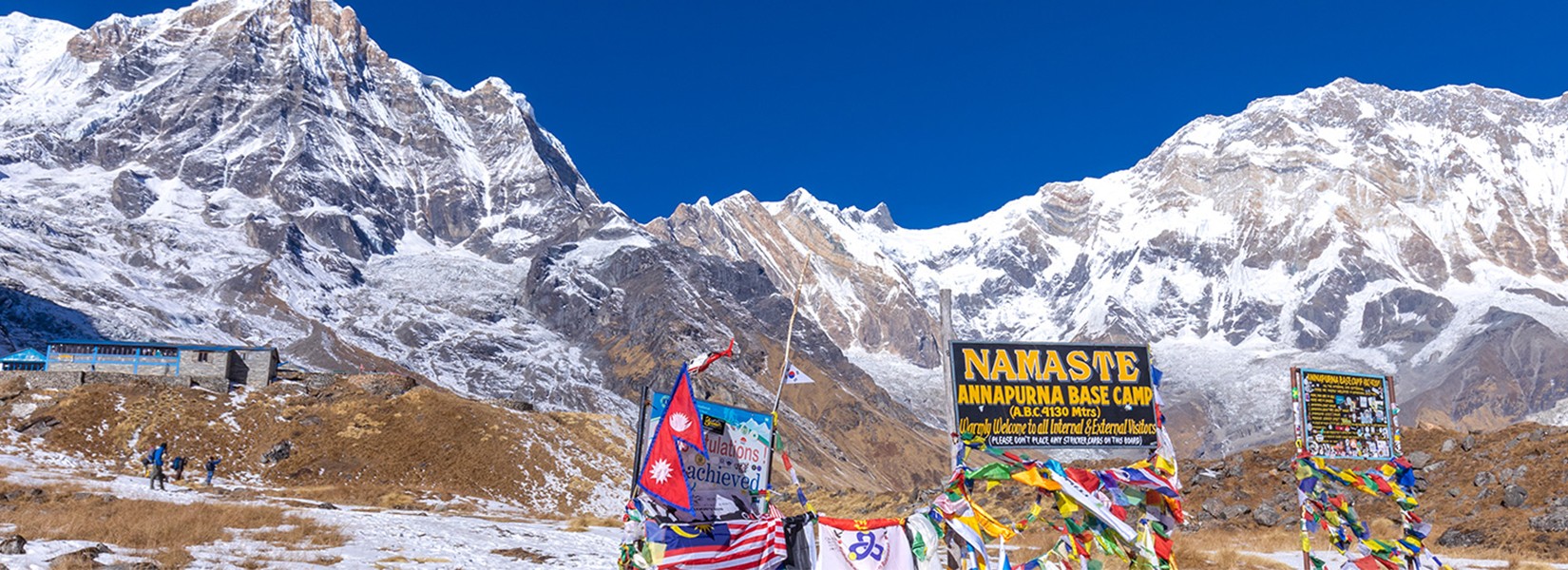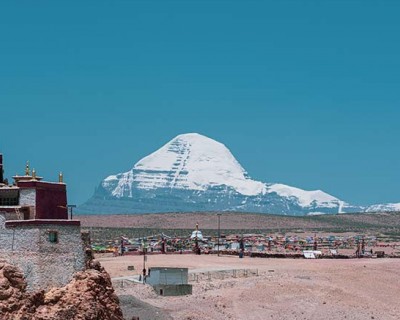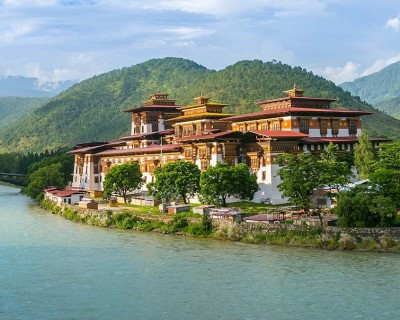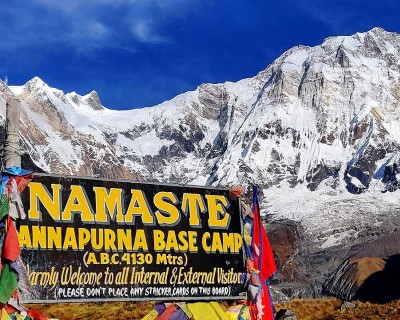Major Factors Affecting Annapurna Base Camp Trek Difficulty
Altitude and Acclimatization
One of the major challenges of high altitude exploration is the risk of Acute Mountain Sickness (AMS) that comes along with it. Although elevation points in this classical Himalayan adventure are not that major, altitude sickness is certainly a major hurdle that contributed to Annapurna Base Camp Trek difficulty. In a standard 11 Days Annapurna Base Camp Trek package, your journey starts after a drive from Pokhara (822m/ 2,696ft) to Nayapul (1,010m/ 3,313ft). You will then slowly follow the winding trail across the slightly elevated points like Ghorepani (2,840m/ 9,317ft) and Poon Hill (3,210m/ 10,531ft) to reach Annapurna Base Camp (4,130m/ 13,549ft) the highest section of this trek.
The total elevation gain in this classical route from the starting point is around 3,120 meters (10,236ft). Even if it is not major like the Annapurna Circuit Trek that stretches across a Himalayan pass and high altitude Everest Base Camp Trek, careful planning and precaution are essential.
Trekking Distance and Duration
This base camp adventure in the central Himalayas is a short and rewarding experience. There are a total of 9 trekking days in this journey and you will need to walk about 5 to 6 hours per day during these periods. Traversing across the mountain trail for multiple hours as the altitude starts to rise gradually is not an easy feat. Thus, for the trekkers who are not physically prepared walking for multiple hours on the rugged mountain route can be a challenging aspect. The total distance of this classical base camp journey is around 110 km (68 miles).
So, that distance is broken down part by part which you will have to cover as per your itinerary plan. The longest walking period on this trek is on Day 8. After exploring the base camp on this day, you will have to trek down to Bamboo (2,345m/ 7,693ft) which will take about 7 to 8 hours.
Terrain and Trail Conditions
The mountain route that leads to base of the Mount Annapurna is a mix of steep ascents and descents, stone steps, dirt trails, river crossing, alpine meadows and even glacier moraines. So, trekkers will have to walk across the diverse landscape as they head toward the basin of the Himalayas. It is challenging enough to navigate your way across these diverse terrains. However, if you are planning your adventure during the off-period, you will have to deal with even more extra set of challenges. For instance, the trails are slippery in the monsoon due to non-stop downpour.
As for the winter, higher elevation parts of the trail are covered in snow which makes the experience more demanding. That’s why it is crucial to select the appropriate period for the trek when the trails are well-maintained and comfortable.
Weather Challenges
Himalayan weather is not always predictable. Even if you are doing this trek during the most favored trekking seasons (i.e. spring and autumn), there can be instances where the weather suddenly changes the tides. You may have to deal with occasional showers and light snowfall even during the core trekking periods. Thus, it is very important to prepare for this weather unpredictability factor of the Himalayas. It will be best if you are flexible with your overall trip as the itinerary may have to be adjusted due to an unfavorable climate.
As this is solely done to criticize the safety and comfort factors, you shouldn’t be critical about it. There is a high rate of weather unpredictability, especially during the off-trekking periods like monsoon and winter.
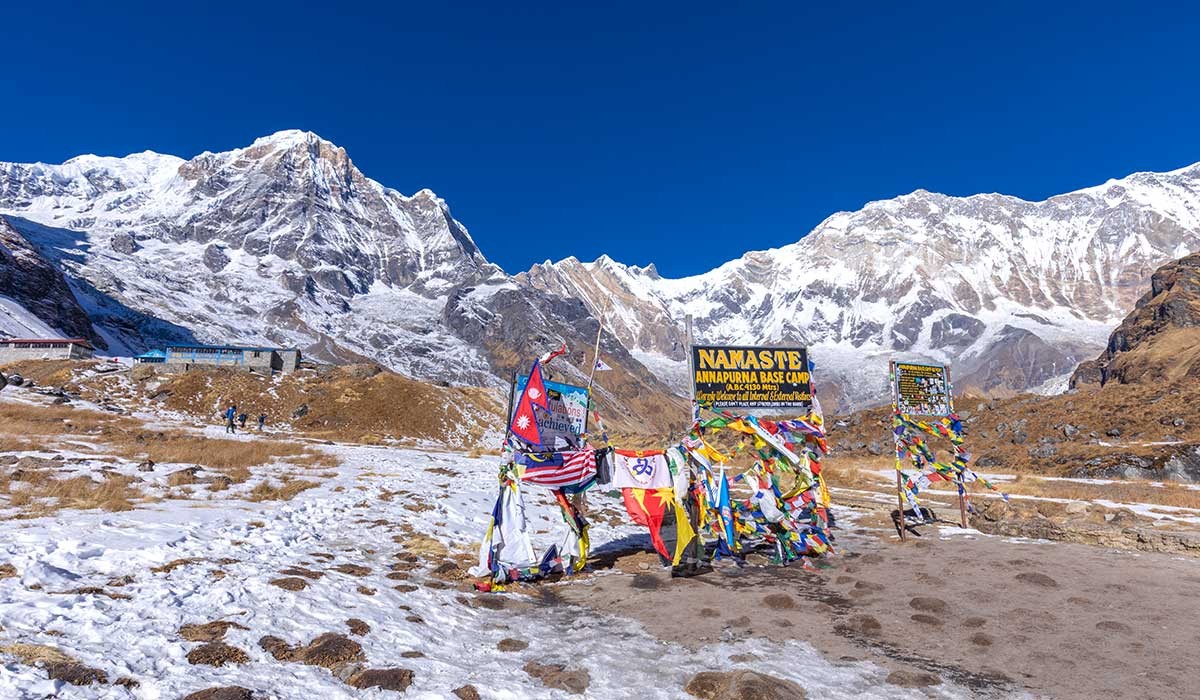
You May Like:Best Time for Annapurna Base Camp Trek
Managing Annapurna Base Camp Trek Difficulty
As you are somewhat familiar with the major aspects of the Annapurna Base Camp Trek difficulty, let’s move on with the countering part. Following these tips will help you enjoy a safe and comfortable adventure on this major Himalayan route.
Physical Fitness Requirements
You need to understand that a good level of fitness will help you defeat the majority of factors that contribute to the difficulty of Annapurna Base Camp Trek. The trekking route of this base camp adventure is not technical, you will just have to overcome rugged mountain terrains and steep segments. With a good level of fitness, it won’t be a hard job and you will also be able to walk for multiple hours. Normally, trekkers are recommended to train for 3 to 6 weeks for this moderate-level Himalayan trek.
But, depending on your experience and fitness level, you can adjust the training period as you see fit. Even if basic fitness is sufficient for this trek, aspiring for the best certainly won’t do any harm. You will have to focus on overall strength, endurance, stamina and flexibility exercises so that your Himalayan trip will be a seamless experience. In case if you have any pre-existing medical conditions, it will be wise to discuss with a doctor and the guide about the trek.
Mental Preparation
It is important to not overlook the mental preparation like most trekkers do. While physical preparation is very crucial for the trek, mental resilience is also equally important. The long hours of walking on the rugged mountain route, fatigue, dealing with remoteness factors, unpredictable weather and the fear of altitude sickness can be tough for the mentally unprepared explorers. If you follow the mental preparation tips below, you will be able to keep yourself motivated and excited for this classical Himalayan journey.
- Don’t set large goals instead break them into smaller portions
- Focus on the positive aspects of the journey like breathtaking scenery, warm hospitality and tasty delicacies
- Doing practice hikes or smaller treks will boost your confidence for the trip
- Be flexible with the itinerary plans and keep a steady pace
- Practise meditation and focused breathing techniques will help you stay calm even while facing challenges
- This is a journey to the remote mountains, so it will be best if you do some practice trying to leave your comfort zone
- Surround yourself with a positive attitude and those who motivate you
Dealing With Altitude Sickness
Even if altitude sickness is a challenging factor of Annapurna Base Camp Trek difficulty, it is not invincible. If you follow the appropriate precautionary measures, you won’t have to worry about its risks during your mountain journey at all. One of the key steps to overcome and minimize the risks of altitude sickness during this trek is to follow a proper acclimatization schedule. Remember, this is very crucial as giving your body enough rest period will help it adapt quickly to rising altitudes. You don’t necessarily have to take acclimatization in this short route, but it is crucial to take enough rest periods and short breaks in between.
Climbing too fast on a winding trail can trigger the symptoms of altitude sickness as your body won’t be adapt to a different atmosphere in time. Similarly, hydration and nutrition also play a key role in minimizing the risk of altitude sickness. A minimum of 2 to 3 liters of water per day during the trek will keep your body’s water level balanced. Similarly, nutritious meals will be good fuel that will prevent fatigue. If you are careful about these aspects you won’t have to worry about the risk of altitude sickness during the trek. Here are some additional tips that will keep the symptoms of altitude sickness at bay.
Additional Tips to Deal With Altitude Sickness
- Follow a gradual ascend during the trek, don’t climb too high too fast
- Eat high carb diet
- Learn to recognize symptoms early
- Avoid sleeping pills and take altitude medication if necessary (consult a doctor first)
- Don’t consume excessive alcohol, caffeine and nicotine
- Dress appropriately and keep yourself warm
- Get a medical check-up before the trek
- Carry energy supplements and electrolytes
- Take extra rest days if necessary
- Travel with an experienced guide who can suggest the best course of action
General Symptoms of Acute Mountain Sickness (AMS): Headache, nausea, fatigue, weakness, vomiting, insomnia, loss of appetite, shortness of breath, etc.
Packing Right
As we have discussed earlier how the weather phenomenon is a crucial component of the Annapurna Base Camp Trek difficulty, it is necessary to pack all the essentials to manage unpredictability and varying climatic conditions on the mountain. Normally, the lower regions on the trail are warm and have moderate climates throughout the year. But, as you move toward the higher region, temperatures start to drop gradually. You will have to pack clothes for this trek considering those factors. Bring comfortable and breezy layers for the lower points but pack insulated and warm clothes for higher regions.
Similarly, packing helpful gear will make your experience even more enriching. Bring a sturdy trekking boot but make sure to break in first. Hiking poles will also make it much easier to navigate the mountain route. As for other essentials, you should consider a sleeping bag, headlamp, backpack, water bottle, thermos, map, compass, powerbank, universal adapter, etc. You also need to prioritize personal care and sanitization items as it may be hard for you to get your favorite brand product at the teahouses on the mountain.
Note: You will need to pack all the essentials and make your packing as light as possible. Normally, trekking agencies assign one porter for two trekkers with a maximum weight limit of 30 kg/ 66 lbs (15 kg/ 33 lbs per trekker). You will have to carry the additional luggage by yourself.
Best Time For Annapurna Base Camp
Selecting a suitable period that comfortably accommodates this mountain journey will also help reduce the overall Annapurna Base Camp Trek difficulty. Doing this classical base camp adventure during one of the peak points {(i.e. spring (March to May) and autumn (September to November)}will eliminate the additional set of challenging factors of the off-seasons. These seasons in general which are the peak trekking period in Nepal are accompanied by stable weather, pleasant temperatures, alluring landscapes and even cultural elements.
So, if you time your trek during one of these points, you can enjoy a safe, comfortable and memorable trip. On the contrary, the off-seasons {i.e. monsoon (June to August) and winter (December to February)} also do have their charming points. But, they also present an additional set of challenges that make the journey even more complex. Trekkers will have to deal with freezing temperatures and snow-covered route during winter. As for monsoons, the slipper trails, the risk of natural disasters (landslide and flood), extreme temperatures and bug and leech-infested trails elevate the difficulty aspects even further.
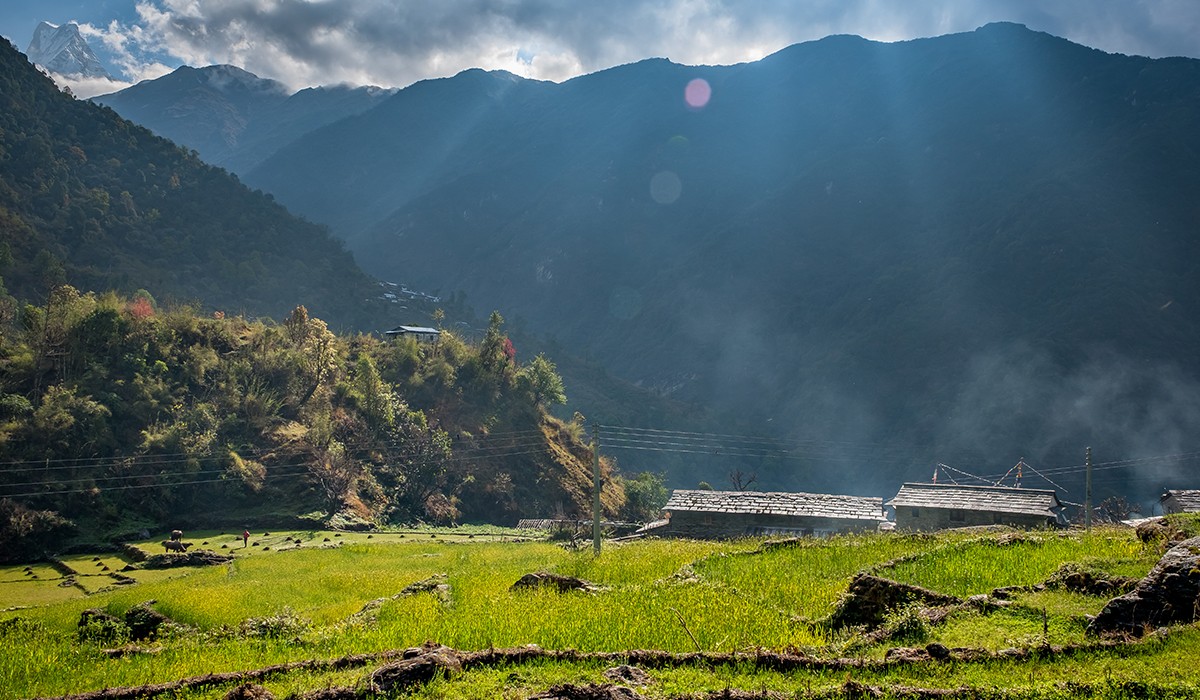
Don’t Miss:Best Time for Annapurna Base Camp Trek
Classification of Difficulty Level Based on Trekking Experience
The difficulty of Annapurna Base Camp Trek also varies based on the previous high altitude trekking experience of the adventurer. Some trekkers will find it manageable while others may struggle due to the altitude gain, remote mountain terrain and physical demand of the trail.
- For Beginner: ABC Trek might not be easiest for the absolute beginner in the high altitude endeavors. However, as it is one of the relatively easier journeys, it is still doable with the right level of preparation. Beginners need to focus on leg strength, endurance and cardio training before starting the trek. Similarly, it is also important to follow a steady pace getting ample rest along the way. Trekking through a reputable agency like Marvel Adventure is highly recommended as they will handle every aspect of the trek including safety and comfort.
- For Intermediate Trekkers: If you have some prior trekking experience in low-altitude treks (2,500 to 3,500 meters), you will find the ABC Trek more manageable. The biggest challenge for you during this classical journey will be the long hours of walking and the risks of altitude sickness. You will also be able to carry your own backpack on this mild route but a good level of stamina is still essential.
- For Experienced Trekkers: Experienced high-altitude trekkers will find this base camp journey moderate or easy. Physically fitness is still crucial as you will have to walk for 5 to 6 hours on average while traversing the mountain route. The main challenges for such trekkers might be the unpredictable weather, altitude adjustment and cold temperatures.
Availability of Drinking Water and Food Along the Route
While doing the Annapurna Base Camp Trek, you will be dependent on the teahouse for food and hydration. These teahouses are run by the natives of the region and offer clean and healthy options. For the drinking water, you can purchase it at the teahouses. You can either go for the bottled option or buy boiled and filtered water at the teahouses. Bottled water can be expensive in higher regions. There are also clean water taps throughout the route, but it may not be safe to drink unless you purify it first.
The best option for hydration during this trek is to carry a water purification solution or tablets and a filter bottle. This way, you will be able to make the water from clean stations drinkable and you won’t have to go for the expensive bottled water option. Buying boiled and filtered water at the teahouse is also the safest option to meet the daily hydration quota.
Food Options at Teahouses
The meals at the teahouses mostly consist of traditional delicacies such as Dal Bhaat, Chapati, Dhido, Gundruk, Momo, Chowmein, Thukpa, Shyaphale, Yak Steak, etc. In this mainstream trekking region, you will also be able to enjoy a wide range of international menus like Pizza, Sandwich, Pasta, Pancake, Omlete, Fries, Steak, Toast, Butter, Honey, Cereals, etc. You will also be able to enjoy a wide variety of vegetarian dishes and the vegan menus are also available in a limited number.
Emergency Evacuation and Medical Facilities
As this is a mainstream trekking region, there are basic medical posts along the route. Primarily, the major villages like Chomrong (2,140m/ 7,020ft) and Bamboo (2,345m/ 7,693ft) also have medical posts that take care of general health issues and emergencies. However, in case of emergency situations, the only option is to transfer to major hospitals in the city areas. The health posts along the route can take care of basic health issues and injuries. But, for serious situations, helicopter rescue is the only option. That’s why it is important to tend to health issues at their minor conditions. As you ascend to higher altitudes, those minor issues can escalate to serious conditions and the limited evacuation options can also make the situation critical.
So, we recommend you to get an appropriate insurance plan for your high-altitude journey. Make sure that your insurance plan also covers the high-altitude rescue if needed. Otherwise, you will have to pay several thousand while using the evacuation service
Impact of Trekking Solo vs. Guided Trek
The Annapurna Base Camp Trek difficulty also varies depending on your trekking preference. Although solo trekking can be a rewarding journey with the solitude experience, there are several challenges that the trekkers need to be mindful of. For instance, navigation of the mountain terrain can be quite challenging. Especially during foggy and snowy conditions. Similarly, carrying all gear on your own adds a physical burden which can affect your overall experience. Even while dealing with sickness or injury, it can be more complex to reach the medical posts or evacuation points.
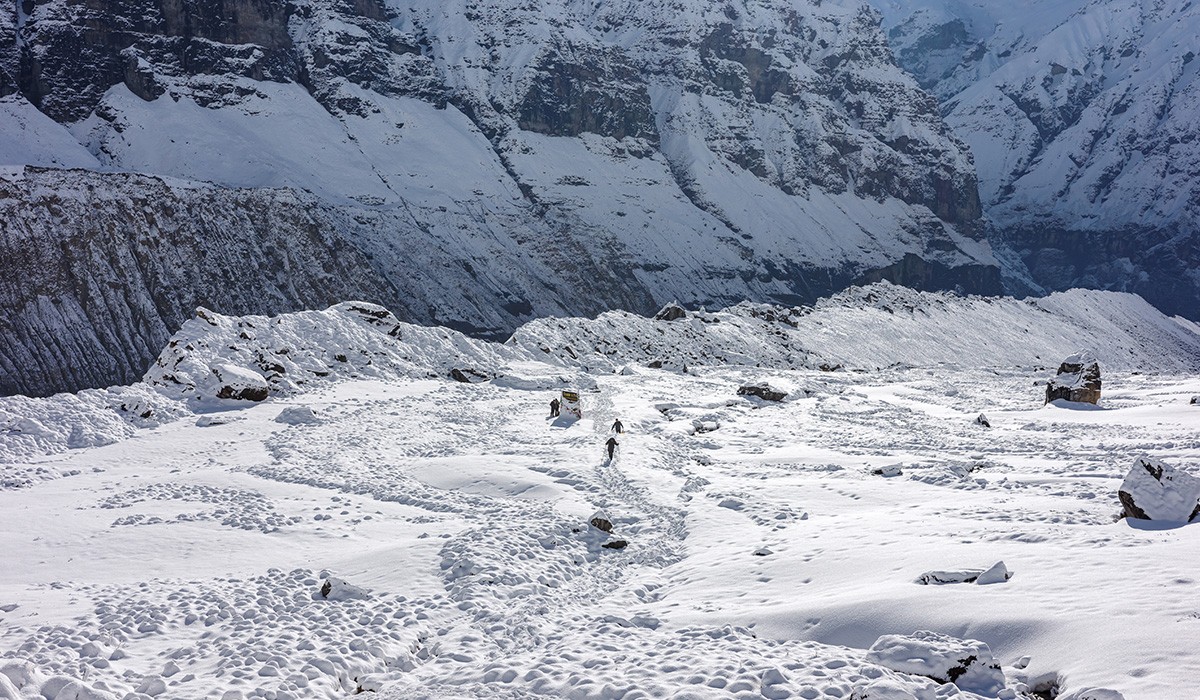
You May Be Interested In:Everest Base Camp Trek Solo Female Travelers
Solo trekkers also have to deal with mental challenges such as loneliness and motivation which have significant effects on the success rate. As for the guided treks, the agency will prioritize the safety and comfort factors. Trekkers also don’t need to worry about navigation as the local expert will be leading the team. If it is a reputable agency like Marvel Adventure, it will also provide helpful portes to assist with the heavy backpack. There is also a chain of social support and motivation in the group trekking. During emergency situations as well, the experts coordinate with the parties involved to take immediate measures.
